祈使句教案
- 格式:doc
- 大小:47.00 KB
- 文档页数:3
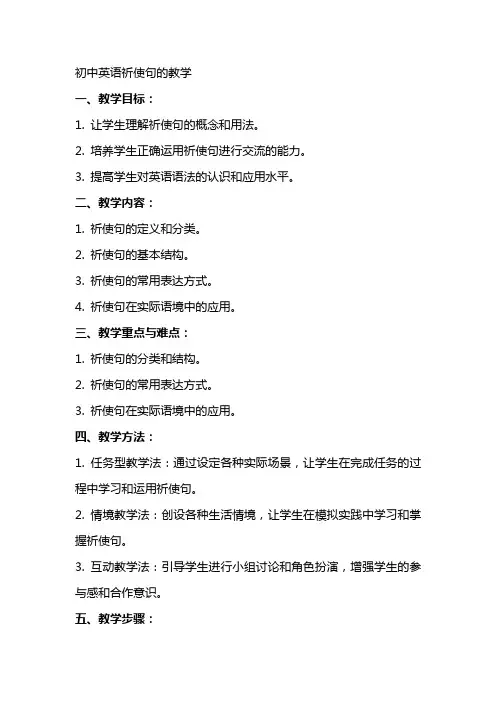
初中英语祈使句的教学一、教学目标:1. 让学生理解祈使句的概念和用法。
2. 培养学生正确运用祈使句进行交流的能力。
3. 提高学生对英语语法的认识和应用水平。
二、教学内容:1. 祈使句的定义和分类。
2. 祈使句的基本结构。
3. 祈使句的常用表达方式。
4. 祈使句在实际语境中的应用。
三、教学重点与难点:1. 祈使句的分类和结构。
2. 祈使句的常用表达方式。
3. 祈使句在实际语境中的应用。
四、教学方法:1. 任务型教学法:通过设定各种实际场景,让学生在完成任务的过程中学习和运用祈使句。
2. 情境教学法:创设各种生活情境,让学生在模拟实践中学习和掌握祈使句。
3. 互动教学法:引导学生进行小组讨论和角色扮演,增强学生的参与感和合作意识。
五、教学步骤:1. 引入:通过图片或故事引导学生了解祈使句的概念。
2. 讲解:讲解祈使句的定义、分类和基本结构。
3. 示例:给出典型例句,分析祈使句的用法。
4. 练习:设计不同类型的练习题,让学生巩固所学内容。
5. 应用:组织学生进行小组讨论或角色扮演,实际运用祈使句进行交流。
6. 总结:对本节课的内容进行总结,强调重点和难点。
7. 作业布置:布置相关作业,让学生进一步巩固所学知识。
六、教学评估:1. 课堂参与度:观察学生在课堂活动中的参与程度,了解他们对祈使句的理解和应用能力。
2. 练习完成情况:检查学生完成练习的情况,评估他们对祈使句的掌握程度。
3. 小组讨论和角色扮演:评估学生在小组讨论和角色扮演中的表现,了解他们实际运用祈使句的能力。
七、教学拓展:1. 对比祈使句和其他句型:引导学生比较祈使句与其他句型的区别,提高他们的语法意识。
2. 祈使句的否定形式:讲解祈使句的否定形式及其用法,让学生能够正确运用。
3. 祈使句的语用功能:探讨祈使句在实际交际中的语用功能,提高学生的交际能力。
八、教学资源:1. 教材:选用合适的英语教材,提供相关祈使句的教学内容。
2. 图片和故事:收集与祈使句相关的图片和故事,用于引入和示例。
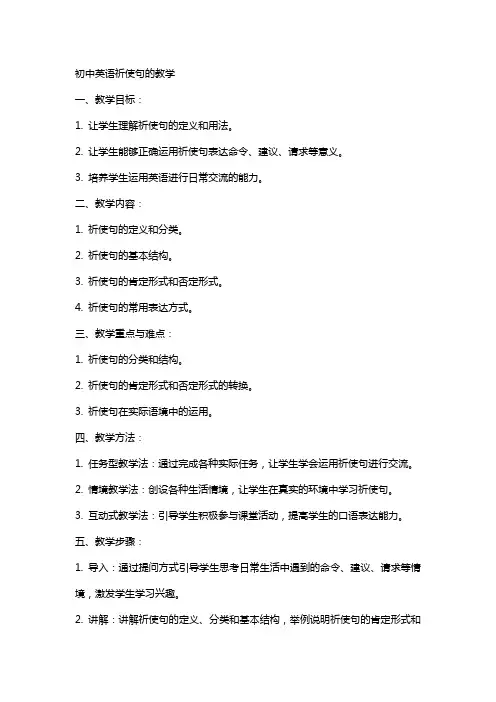
初中英语祈使句的教学一、教学目标:1. 让学生理解祈使句的定义和用法。
2. 让学生能够正确运用祈使句表达命令、建议、请求等意义。
3. 培养学生运用英语进行日常交流的能力。
二、教学内容:1. 祈使句的定义和分类。
2. 祈使句的基本结构。
3. 祈使句的肯定形式和否定形式。
4. 祈使句的常用表达方式。
三、教学重点与难点:1. 祈使句的分类和结构。
2. 祈使句的肯定形式和否定形式的转换。
3. 祈使句在实际语境中的运用。
四、教学方法:1. 任务型教学法:通过完成各种实际任务,让学生学会运用祈使句进行交流。
2. 情境教学法:创设各种生活情境,让学生在真实的环境中学习祈使句。
3. 互动式教学法:引导学生积极参与课堂活动,提高学生的口语表达能力。
五、教学步骤:1. 导入:通过提问方式引导学生思考日常生活中遇到的命令、建议、请求等情境,激发学生学习兴趣。
2. 讲解:讲解祈使句的定义、分类和基本结构,举例说明祈使句的肯定形式和否定形式。
3. 练习:让学生分组进行祈使句的肯定形式和否定形式的转换练习,教师给予指导和反馈。
4. 情境模拟:创设生活情境,让学生运用祈使句进行角色扮演,模拟实际交流过程。
5. 总结:对本节课所学内容进行总结,强调祈使句在日常交流中的重要性。
6. 作业布置:让学生课后用祈使句编写一段对话,明天上课时进行分享。
7. 课后反思:根据学生的课堂表现和作业完成情况,对教学效果进行评估和调整。
六、教学活动设计:1. 小组合作:学生分成小组,每组设计一个祈使句的场景,如家庭生活、学校生活、公共场所等。
2. 角色扮演:学生分组进行角色扮演,一个学生发出祈使句,另一个学生执行。
通过这种方式,学生可以在实际语境中学会使用祈使句。
3. 竞赛游戏:设计一个祈使句竞赛游戏,学生轮流给出祈使句,其他学生快速反应执行。
提高学生的积极性和口语表达能力。
七、教学评价:1. 课堂参与度:观察学生在课堂活动中的参与程度,鼓励积极发言和互动。
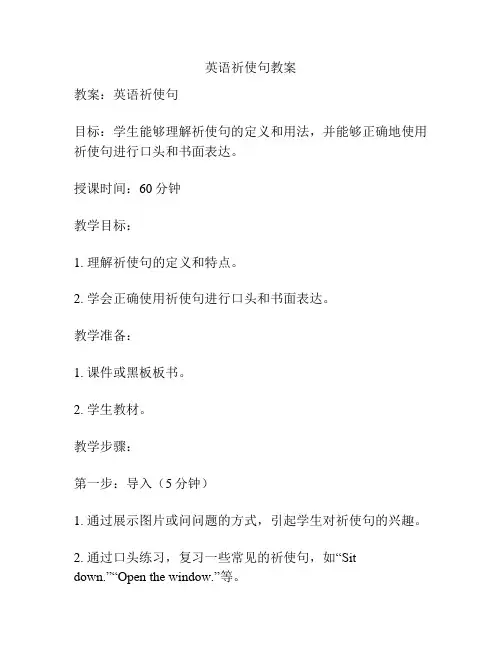
英语祈使句教案教案:英语祈使句目标:学生能够理解祈使句的定义和用法,并能够正确地使用祈使句进行口头和书面表达。
授课时间:60分钟教学目标:1. 理解祈使句的定义和特点。
2. 学会正确使用祈使句进行口头和书面表达。
教学准备:1. 课件或黑板板书。
2. 学生教材。
教学步骤:第一步:导入(5分钟)1. 通过展示图片或问问题的方式,引起学生对祈使句的兴趣。
2. 通过口头练习,复习一些常见的祈使句,如“Sit down.”“Open the window.”等。
第二步:介绍祈使句(15分钟)1. 呈现祈使句的定义:祈使句是一种特殊的句子结构,用来表达命令、请求、建议或劝告。
2. 通过例句向学生展示不同类型的祈使句,并解释其用法。
3. 强调祈使句的特点:一般省略主语,动词直接用原形,句子末尾可以加感叹号或句号。
第三步:练习使用祈使句(25分钟)1. 给学生分发练习题或出示相关练习题目。
2. 让学生根据提示写出正确的祈使句,并检查答案。
3. 设计一些情景,让学生进行口头表达。
例如,让学生假设自己是老师,给同学下达一些命令。
4. 分组讨论,让学生以小组为单位,设计一段对话,要求尽可能多地使用祈使句。
第四步:总结与拓展(10分钟)1. 总结祈使句的定义和特点,并给学生总结一些常用的祈使句。
2. 鼓励学生运用所学内容,进行更多的练习和拓展。
教学反馈:1. 教师可以通过随堂练习、小组讨论和个人对话等方式,及时检查学生的理解和学习进展。
2. 教师可以根据学生的反馈,调整教学方法和内容,以促进学生的主动参与和积极学习。
教学延伸:1. 让学生自主收集更多的祈使句,并加以分类和运用。
2. 引导学生通过阅读和听力材料,积累更多的祈使句,并运用到实际生活中。
3. 教师可以设计一些小组活动,让学生在情境中使用祈使句,提高实际应用能力。
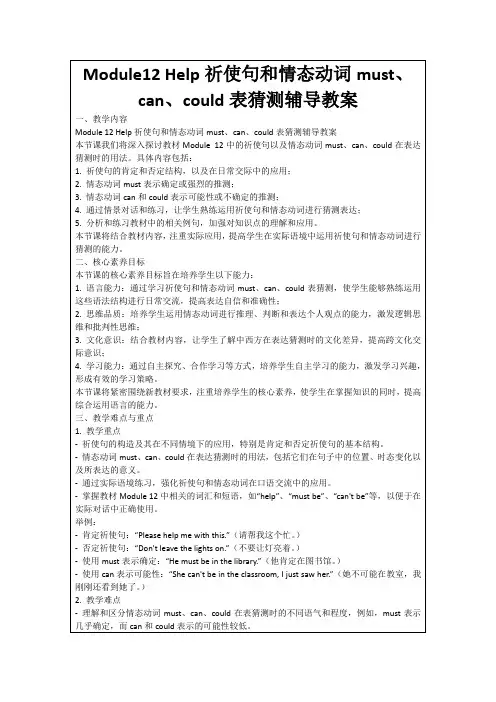
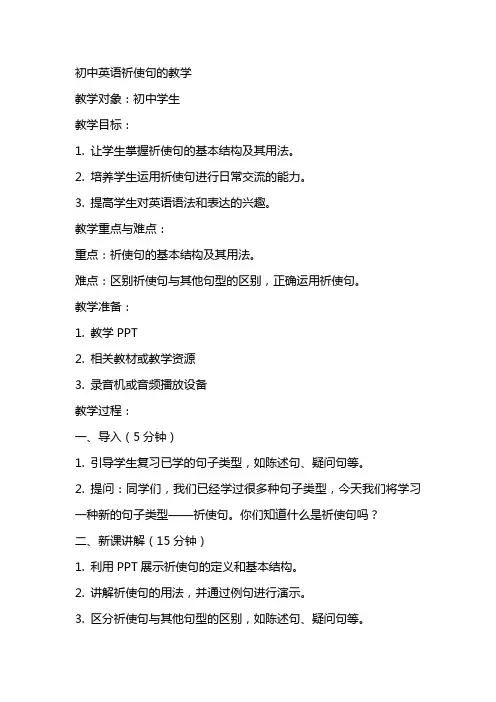
初中英语祈使句的教学教学对象:初中学生教学目标:1. 让学生掌握祈使句的基本结构及其用法。
2. 培养学生运用祈使句进行日常交流的能力。
3. 提高学生对英语语法和表达的兴趣。
教学重点与难点:重点:祈使句的基本结构及其用法。
难点:区别祈使句与其他句型的区别,正确运用祈使句。
教学准备:1. 教学PPT2. 相关教材或教学资源3. 录音机或音频播放设备教学过程:一、导入(5分钟)1. 引导学生复习已学的句子类型,如陈述句、疑问句等。
2. 提问:同学们,我们已经学过很多种句子类型,今天我们将学习一种新的句子类型——祈使句。
你们知道什么是祈使句吗?二、新课讲解(15分钟)1. 利用PPT展示祈使句的定义和基本结构。
2. 讲解祈使句的用法,并通过例句进行演示。
3. 区分祈使句与其他句型的区别,如陈述句、疑问句等。
4. 引导学生进行祈使句的练习,巩固所学知识。
三、听力练习(10分钟)1. 播放一段含有祈使句的对话或短文。
2. 学生听后,回答相关问题。
3. 教师针对学生的回答进行点评和指导。
四、课堂活动(10分钟)1. 学生分成小组,进行祈使句的角色扮演。
2. 各小组展示后,其他学生进行评价。
3. 教师针对学生的表现进行点评和指导。
五、课后作业(布置作业,巩固所学)1. 让学生课后运用所学知识,编写一个含有祈使句的对话或短文。
2. 要求学生在课后将作业交给教师,以便进行批改和反馈。
教学反思:本节课通过讲解、练习、听力、角色扮演等多种教学活动,使学生掌握了祈使句的基本结构及其用法。
在教学过程中,要注意关注学生的学习情况,及时进行点评和指导,确保学生能够正确运用祈使句。
要注重激发学生的学习兴趣,提高他们对英语语法和表达的热情。
六、祈使句的时态和语气(10分钟)1. 讲解祈使句的时态和语气,如一般现在时、一般过去时、一般将来时等。
2. 通过例句演示祈使句的时态和语气变化。
3. 学生进行祈使句时态和语气的练习,巩固所学知识。
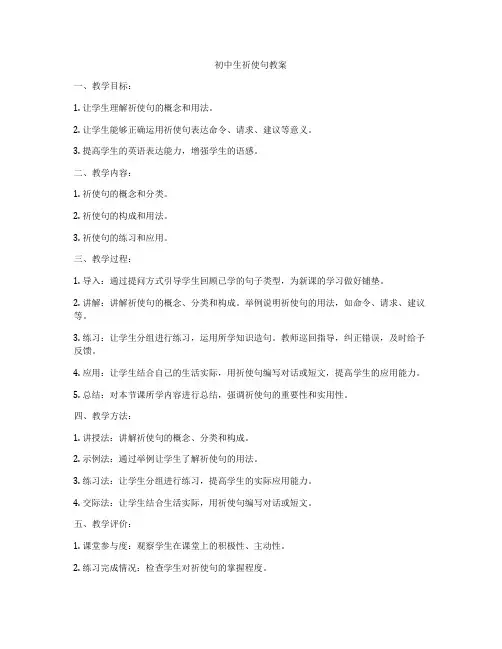
初中生祈使句教案一、教学目标:1. 让学生理解祈使句的概念和用法。
2. 让学生能够正确运用祈使句表达命令、请求、建议等意义。
3. 提高学生的英语表达能力,增强学生的语感。
二、教学内容:1. 祈使句的概念和分类。
2. 祈使句的构成和用法。
3. 祈使句的练习和应用。
三、教学过程:1. 导入:通过提问方式引导学生回顾已学的句子类型,为新课的学习做好铺垫。
2. 讲解:讲解祈使句的概念、分类和构成。
举例说明祈使句的用法,如命令、请求、建议等。
3. 练习:让学生分组进行练习,运用所学知识造句。
教师巡回指导,纠正错误,及时给予反馈。
4. 应用:让学生结合自己的生活实际,用祈使句编写对话或短文,提高学生的应用能力。
5. 总结:对本节课所学内容进行总结,强调祈使句的重要性和实用性。
四、教学方法:1. 讲授法:讲解祈使句的概念、分类和构成。
2. 示例法:通过举例让学生了解祈使句的用法。
3. 练习法:让学生分组进行练习,提高学生的实际应用能力。
4. 交际法:让学生结合生活实际,用祈使句编写对话或短文。
五、教学评价:1. 课堂参与度:观察学生在课堂上的积极性、主动性。
2. 练习完成情况:检查学生对祈使句的掌握程度。
3. 应用能力:评估学生在实际情景中运用祈使句的能力。
六、教学资源:1. PPT课件:展示祈使句的例子、练习题等。
2. 教材:提供祈使句的相关知识点。
3. 录音机、磁带:用于播放祈使句的例句。
4. 黑板、粉笔:用于板书和讲解。
七、教学步骤:1. 第一步:导入(5分钟)通过提问方式引导学生回顾已学的句子类型,为新课的学习做好铺垫。
2. 第二步:讲解(10分钟)讲解祈使句的概念、分类和构成。
举例说明祈使句的用法,如命令、请求、建议等。
3. 第三步:练习(15分钟)让学生分组进行练习,运用所学知识造句。
教师巡回指导,纠正错误,及时给予反馈。
4. 第四步:应用(10分钟)让学生结合自己的生活实际,用祈使句编写对话或短文,提高学生的应用能力。
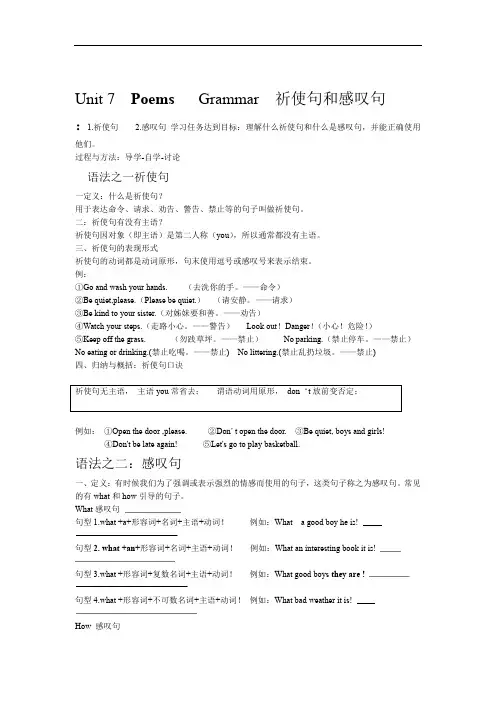
Unit 7 Poems Grammar 祈使句和感叹句:1.祈使句 2.感叹句学习任务达到目标:理解什么祈使句和什么是感叹句,并能正确使用他们。
过程与方法:导学-自学-讨论语法之一祈使句一定义:什么是祈使句?用于表达命令、请求、劝告、警告、禁止等的句子叫做祈使句。
二:祈使句有没有主语?祈使句因对象(即主语)是第二人称(you),所以通常都没有主语。
三、祈使句的表现形式祈使句的动词都是动词原形,句末使用逗号或感叹号来表示结束。
例:①Go and wash your hands. (去洗你的手。
——命令)②Be quiet,please.(Please be quiet.)(请安静。
——请求)③Be kind to your sister.(对姊妹要和善。
——劝告)④Watch your steps.(走路小心。
——警告)Look out!Danger!(小心!危险!)⑤Keep off the grass. (勿践草坪。
——禁止)No parking.(禁止停车。
——禁止)No eating or drinking.(禁止吃喝。
——禁止) No littering.(禁止乱扔垃圾。
——禁止)四、归纳与概括:祈使句口诀例如:①Open the door ,please. ②Don't open the door. ③Be quiet, boys and girls!④Don't be late again! ⑤Let's go to play basketball.语法之二:感叹句一、定义:有时候我们为了强调或表示强烈的情感而使用的句子,这类句子称之为感叹句。
常见的有what和how引导的句子。
What感叹句句型1.what +a+形容词+名词+主语+动词!例如:What a good boy he is!句型2. what +an+形容词+名词+主语+动词!例如:What an interesting book it is!句型3.what +形容词+复数名词+主语+动词!例如:What good boys they are !句型4.what +形容词+不可数名词+主语+动词!例如:What bad weather it is!How 感叹句How +形容词/副词+主语+动词!例如“①How beautiful she is ! ②How clever that boy is !②How slowly you walk! ④How fast the teacher speaks!小结::祈使句和感叹句一.改正句子中的错误1.Opening the door ,please.2.Don't late again.3.Let's doing some cleaning.4.To turn to page 94.5.Quiet, boys and girls!二、根据要求改写句子1.Put put the books on the desk.(改为否定句)_________ __________ the books on the desk.2.How interesting the story is ! (改为同义句)_______ ______ interesting story it is !3.What a beautiful day! (改为同义句)______ _________ the day is!4.Be quiet, please! (改为否定句)_______ ________quiet!三.单项选择1.__________delicious the food is ! A.What B.How C.What aD. How a2.__________strange clothes he is wearing ! A.What B.How C.What aD. How a3.________interesting story it is ! A.What B.How C.What anD. How an4._______windy it was yesterday! A.What B.How C.What aD. How a5._______careful boy you are ! A.What B.How C.What aD. How a6._______fast he can run ! A.What B.How C.What a D. How a7._______exciting news it is ! A.What B.How C.What anD. How a8. Don't ________, Jack. A.talk B.talks C.talkingD. to talk9._______beautiful girl she is ! A.What B.How C.What a D. How a10._______bad weather it is ! A.What B.How C.What a D. How a四.根据括号里的提示词,把下列句子改成感叹句1.You are wearing an old shirt.(what)2.The boys are very excited.(how)3.He is a lovely person.(what)4.She is very unlucky .(how)5.We have watched an exciting film .(what)。
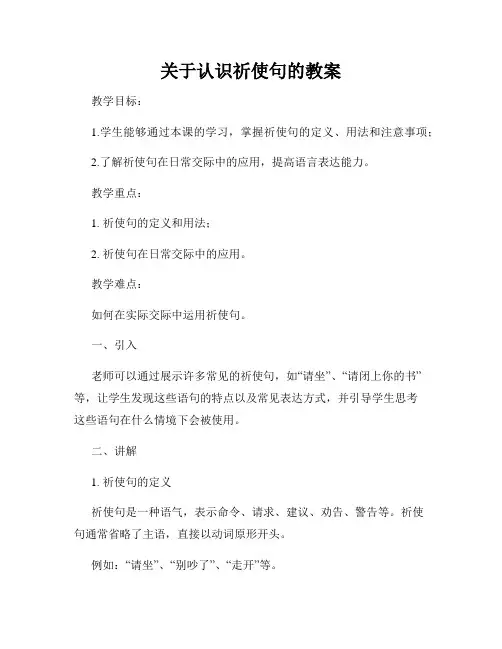
关于认识祈使句的教案教学目标:1.学生能够通过本课的学习,掌握祈使句的定义、用法和注意事项;2.了解祈使句在日常交际中的应用,提高语言表达能力。
教学重点:1. 祈使句的定义和用法;2. 祈使句在日常交际中的应用。
教学难点:如何在实际交际中运用祈使句。
一、引入老师可以通过展示许多常见的祈使句,如“请坐”、“请闭上你的书”等,让学生发现这些语句的特点以及常见表达方式,并引导学生思考这些语句在什么情境下会被使用。
二、讲解1. 祈使句的定义祈使句是一种语气,表示命令、请求、建议、劝告、警告等。
祈使句通常省略了主语,直接以动词原形开头。
例如:“请坐”、“别吵了”、“走开”等。
2. 祈使句的用法祈使句常用于以下情况:(1)命令、请求、建议、劝告、警告等:例如:“请给我一杯水。
”、“别吵了,好好学习。
”、“走开,不要打扰我。
”(2)表示愿望或希望:例如:“祝你生日快乐。
”、“愿你早日康复。
”(3)表示感叹或揭示:例如:“好久不见!”、“听我说,这个故事真的很有趣。
”3. 祈使句的注意事项(1)祈使句的主语通常省略,即不用表示命令的执行人是谁;(2)祈使句的动词一般以原形呈现,即不加任何变化、词尾不加s/es、不用时态及人称的变化。
三、练习让学生在组内自由讨论,围绕祈使句的各种应用,分别进行语境训练,如:(1)某同学上课迟到了,如何通过祈使句引导他准时到达。
(2)你想要对你的朋友说服他去看电影,你会用什么样的祈使句。
(3)你想让你的妹妹帮你拿水,请你用适当的祈使句。
四、应用1. 在现实生活中,人们常常会使用祈使句作为交际工具,可以很好地传达命令或需求。
例如:(1)餐厅服务员:“请您稍等一下,这就为您端上来。
”(2)家长对孩子:“别玩了,好好学习。
”(3)教练对运动员:“跑步时注意脚步和呼吸。
”2. 在广告中,也经常使用祈使句,向人们传达某些信息。
例如:(1)饮料广告:“喝下一口,更舒适。
”(2)服装广告:“穿上这件衣服,更自信。
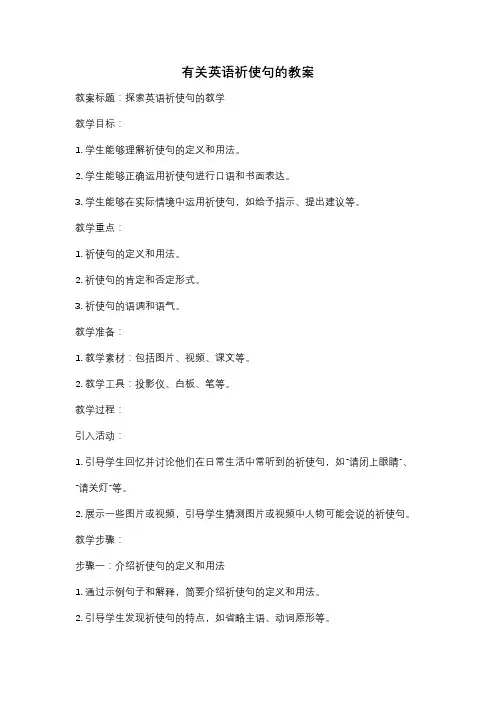
有关英语祈使句的教案教案标题:探索英语祈使句的教学教学目标:1. 学生能够理解祈使句的定义和用法。
2. 学生能够正确运用祈使句进行口语和书面表达。
3. 学生能够在实际情境中运用祈使句,如给予指示、提出建议等。
教学重点:1. 祈使句的定义和用法。
2. 祈使句的肯定和否定形式。
3. 祈使句的语调和语气。
教学准备:1. 教学素材:包括图片、视频、课文等。
2. 教学工具:投影仪、白板、笔等。
教学过程:引入活动:1. 引导学生回忆并讨论他们在日常生活中常听到的祈使句,如“请闭上眼睛”、“请关灯”等。
2. 展示一些图片或视频,引导学生猜测图片或视频中人物可能会说的祈使句。
教学步骤:步骤一:介绍祈使句的定义和用法1. 通过示例句子和解释,简要介绍祈使句的定义和用法。
2. 引导学生发现祈使句的特点,如省略主语、动词原形等。
步骤二:祈使句的肯定和否定形式1. 介绍祈使句的肯定形式,如“Sit down.”、“Open the window.”等。
2. 介绍祈使句的否定形式,如“Don't sit down.”、“Don't open the window.”等。
3. 强调祈使句的否定形式中使用助动词“don't”。
步骤三:祈使句的语调和语气1. 引导学生注意祈使句的语调和语气,如命令、请求、建议等。
2. 通过示例句子和角色扮演,让学生感受不同语气下的祈使句的表达方式。
步骤四:练习和应用1. 提供一些练习题,让学生判断句子是陈述句还是祈使句,并进行改写。
2. 给学生提供实际情境,让他们运用祈使句进行角色扮演,如在餐厅点菜、给予指示等。
总结和评价:1. 对学生进行简要总结,强调祈使句的定义、用法和语气。
2. 通过口头或书面评价,检查学生对祈使句的掌握程度。
拓展活动:1. 鼓励学生在日常生活中积极运用祈使句,如家务活、团队合作等。
2. 提供更多的练习题和实际情境,让学生进一步巩固和应用所学的内容。
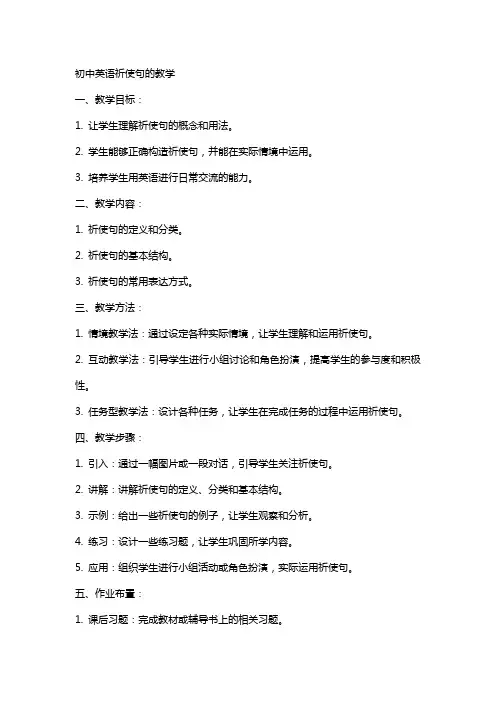
初中英语祈使句的教学一、教学目标:1. 让学生理解祈使句的概念和用法。
2. 学生能够正确构造祈使句,并能在实际情境中运用。
3. 培养学生用英语进行日常交流的能力。
二、教学内容:1. 祈使句的定义和分类。
2. 祈使句的基本结构。
3. 祈使句的常用表达方式。
三、教学方法:1. 情境教学法:通过设定各种实际情境,让学生理解和运用祈使句。
2. 互动教学法:引导学生进行小组讨论和角色扮演,提高学生的参与度和积极性。
3. 任务型教学法:设计各种任务,让学生在完成任务的过程中运用祈使句。
四、教学步骤:1. 引入:通过一幅图片或一段对话,引导学生关注祈使句。
2. 讲解:讲解祈使句的定义、分类和基本结构。
3. 示例:给出一些祈使句的例子,让学生观察和分析。
4. 练习:设计一些练习题,让学生巩固所学内容。
5. 应用:组织学生进行小组活动或角色扮演,实际运用祈使句。
五、作业布置:1. 课后习题:完成教材或辅导书上的相关习题。
2. 实践任务:与同学合作,用祈使句完成一项任务。
3. 自主学习:查找资料,了解祈使句的其他表达方式。
六、教学评估:1. 课堂参与度:观察学生在课堂活动中的参与情况,了解他们对祈使句的理解和应用能力。
2. 练习完成情况:检查学生完成练习题的情况,评估他们对祈使句的掌握程度。
3. 小组活动:评估学生在小组讨论和角色扮演中的表现,关注他们的交流能力和合作精神。
七、拓展活动:1. 制作祈使句海报:让学生分组,每组设计一幅关于祈使句的海报,包括祈使句的定义、分类和例句等。
2. 祈使句表演赛:学生分组进行祈使句表演,看哪组能够最准确、最有趣地运用祈使句。
八、教学反思:在课后,教师应反思本节课的教学效果,包括学生的学习兴趣、课堂活动的组织、教学内容的难易程度等,以便在今后的教学中进行调整和改进。
九、课后作业:1. 复习祈使句的相关知识,整理笔记。
2. 与家人或朋友合作,用祈使句完成一项日常任务,如安排周末活动等。
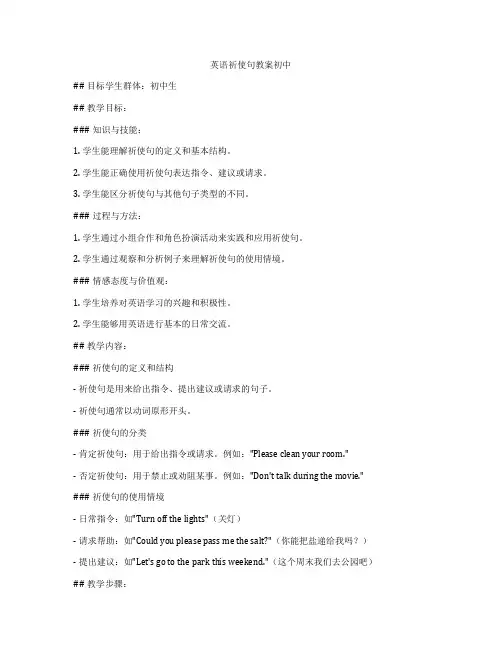
英语祈使句教案初中## 目标学生群体:初中生## 教学目标:### 知识与技能:1. 学生能理解祈使句的定义和基本结构。
2. 学生能正确使用祈使句表达指令、建议或请求。
3. 学生能区分祈使句与其他句子类型的不同。
### 过程与方法:1. 学生通过小组合作和角色扮演活动来实践和应用祈使句。
2. 学生通过观察和分析例子来理解祈使句的使用情境。
### 情感态度与价值观:1. 学生培养对英语学习的兴趣和积极性。
2. 学生能够用英语进行基本的日常交流。
## 教学内容:### 祈使句的定义和结构- 祈使句是用来给出指令、提出建议或请求的句子。
- 祈使句通常以动词原形开头。
### 祈使句的分类- 肯定祈使句:用于给出指令或请求。
例如:"Please clean your room."- 否定祈使句:用于禁止或劝阻某事。
例如:"Don't talk during the movie." ### 祈使句的使用情境- 日常指令:如"Turn off the lights"(关灯)- 请求帮助:如"Could you please pass me the salt?"(你能把盐递给我吗?)- 提出建议:如"Let's go to the park this weekend."(这个周末我们去公园吧)## 教学步骤:1. 引入新课- 向学生介绍祈使句的概念,并提问:"你们在日常生活中有没有给过别人指令或建议?"2. 讲解与示范- 通过示例讲解祈使句的定义和结构。
- 展示肯定祈使句和否定祈使句的例子,并让学生跟读。
3. 练习活动- 分学生成小组,每组编写一个场景,使用祈使句来描述小组成员之间的互动。
- 让学生在小组内角色扮演,实践使用祈使句。
4. 游戏与竞赛- 设计一个祈使句接龙游戏,学生轮流说出一个祈使句,下一个人需要根据这个祈使句继续接下去。
初中祈使句教案教案标题:初中祈使句教案一、教学目标:1. 理解和能正确使用祈使句的基本概念;2. 能分析祈使句的结构和语法特点;3. 掌握祈使句的基本用法和常见的动词;4. 能运用祈使句表达日常交际中的要求和建议;5. 提高学生听、说、读、写的能力。
二、教学重点:1. 理解祈使句的定义和基本结构;2. 掌握祈使句的主要语法特点和常见的动词;3. 能正确运用祈使句表达日常交际中的要求和建议。
三、教学难点:1. 祈使句的否定形式及其常见的动词;2. 祈使句中的主语省略问题;3. 祈使句的直接和间接表达。
四、教学准备:1. PPT或教学板书;2. 教材《初中英语》教科书及配套练习题;3. 声音录制设备。
五、教学过程:Step 1:导入(5分钟)1. 利用教学PPT或教学板书,引导学生回顾陈述句、疑问句和感叹句的定义和基本结构。
2. 通过问题引导:a. Do you remember how to make requests or express commands in English?(你还记得如何在英语中提出请求或表达命令吗?)b. Can you think of any examples?(你能想出一些例子吗?)Step 2:新知讲解(15分钟)1. 教师讲解祈使句的定义和基本结构,强调祈使句的特点是省略主语,动词原型在句首。
同时对祈使句的肯定和否定形式做出解释。
2. 教师讲解祈使句的常见动词,例如:sit down, stand up, be quiet, listen, clean, etc. 强调这些动词在祈使句中的用法和意义。
3. 示范和练习:教师以对学生提出的不同请求进行祈使句的回应,同时让学生模仿教师的回答。
例如:a. Student: Can I go to the restroom?(我可以去洗手间吗?)Teacher: Sure, go ahead.(当然可以,请去吧。
)b. Student: May I open the window?(我可以打开窗户吗?)Teacher: No, you can't. It's too cold.(不,你不能。
初中祈使句语法课教案1. 让学生掌握祈使句的定义、分类和基本结构。
2. 培养学生正确运用祈使句进行交际的能力。
3. 提高学生对英语语法的学习兴趣。
二、教学内容1. 祈使句的定义和分类2. 祈使句的基本结构3. 祈使句的常用表达方式4. 祈使句在实际交际中的应用三、教学过程1. 导入新课通过展示日常生活中的一些场景图片,引导学生思考并用英语表达这些场景。
例如:排队、保持安静、禁止吸烟等。
让学生注意到这些表达都是命令句,也就是今天我们要学习的祈使句。
2. 讲解祈使句(1)祈使句的定义:祈使句是用来表达命令、请求、建议等语气的句子。
(2)祈使句的分类:① 命令句:表示命令,语气较强,通常以动词原形开头。
② 请求句:表示请求,语气较弱,通常以“Could you please”或“Would you mind”等开头。
③ 建议句:表示建议,语气较委婉,通常以“Could”,“Should”或“May”等开头。
(3)祈使句的基本结构:动词原形/情态动词+动词原形+其他3. 祈使句的常用表达方式展示一些常用的祈使句表达方式,如:(1)表示命令:- Sit down!- Quiet, please!- Hands off!(2)表示请求:- Could you please pass me the salt?- Would you mind closing the window?(3)表示建议:- Let’s go out for a walk.- Why don’t we watch a movie together?4. 祈使句在实际交际中的应用通过角色扮演、小组讨论等方式,让学生在实际语境中运用祈使句进行交流。
例如:在教室里、在家里、在公共场所等场景下,用祈使句表达自己的要求或建议。
5. 课堂练习设计一些祈使句的练习题,让学生进行书面和口头练习。
例如:(1)用祈使句完成下面的句子:- 请关上门。
(Close the door.)- 请安静下来。
小学语文教案:学习感叹句和祈使句的用法学习感叹句和祈使句的用法一、引言语文教学是小学教育的重要一环,教师需要通过巧妙的教案设计来引导学生掌握语言表达的基本技巧。
本文将介绍学习感叹句和祈使句的用法,并提供相应的教学方案。
二、感叹句的用法及教学方法感叹句是表达强烈感情和情绪的一种句型,用来表达对人、事物、事情的赞美、评价、称赞、惊奇等感受。
学生学习感叹句的用法有助于提高他们的语言表达能力和情感体验能力。
1.感叹句的基本结构感叹句常用的句型结构为:“多/太+形容词/副词/程度副词+主语+谓语”,例如:“多么美丽的花啊!”、“太棒了!”、“太好了!”等。
2.感叹句的教学方法在教学过程中,老师可以通过创设情境、使用多媒体教具、进行角色扮演等方式激发学生对感叹句的兴趣。
同时,老师可选择一些生动、形象的例句,让学生仿写,并鼓励他们用感叹句来表达自己的情感。
三、祈使句的用法及教学方法祈使句是一种特殊的句型,用于表示命令、请求、劝告、建议等。
学生掌握祈使句的用法可以提高他们的语言表达能力,使他们更有信心地与他人进行交流和表达意见。
1.祈使句的基本结构祈使句的基本结构为:“动词+其他成分”,例如:“请关窗户。
”、“不要害怕。
”等。
2.祈使句的教学方法在教学中,老师可以设计一些生活化的情境,让学生运用祈使句来进行角色扮演和实际操作。
同时,老师还可以使用多媒体教具,展示祈使句在日常生活中的实际运用,激发学生学习的积极性和学习兴趣。
四、感叹句和祈使句的练习与巩固为了帮助学生更好地掌握感叹句和祈使句的用法,教师可以设计一些练习活动来巩固学习成果。
1.感叹句的练习活动a) 列出一些图片或实物,要求学生用感叹句来描述。
b) 给学生分发一些有关事物或人物的描述句子,要求他们改写成感叹句。
2.祈使句的练习活动a) 设计一个情境,让学生用祈使句来表达对他人的请求或命令。
b) 分发一些带有标点错误的祈使句,要求学生找出并改正错误。
五、教学反思通过学习感叹句和祈使句的用法,学生可以提高他们的语言表达能力和情感体验能力。
六年级英语祈使句教案小学六年级英语语法祈使句教案祈使句王国卫队Hello,boysandgirls!"英语祈使句王国"的职责是用来表示请求、命令、建议、禁止等。
这个王国的特点是通常没有主语,多以动词原形开始。
下面,看看王国中"六兄弟"的表演吧!I.大哥V[档案]V+宾语+其它成分[表演]①closetheindo.关上窗户。
②Helpyourselftosoefish.随便吃点鱼吧。
II.二哥B[档案]Be+表语+其它成分[表演]①Beagoodstudent!做个好学生!②Bequiet!安静!III.三哥L[档案]Let+宾语+动词原形+其它成分[表演]①Let'sgohoe!咱们回家吧!②Letherin.让她进来。
IV.四哥D[档案]Don't+动词原形+其它成分[表演]①Don'tbelate.不要迟到。
②Don'treadinthesun.别在阳光下看书。
V.五哥P[档案]Please+动词短语[表演]Pleasesitdon.=Sitdon,please.请坐。
VI.六弟N[档案]No+名词或动名词[表演]①Nophotos!禁止拍照!②Nosoing!禁止吸烟!"六兄弟"为了和小朋友们交个朋友,把英语祈使句王国的"秘笈"也一并奉献给大家:祈使句,无主语,只用谓语就可以。
表示请求或命令,加上please表客气。
Standup,please!请起立!ehere.来这里。
如果变成否定句,Don't开头是规律。
Nofishing!是警示语,祈使句用法要牢记。
小学语文教案:学习感叹句和祈使句的用法学习感叹句和祈使句的用法一、引言在小学语文教学中,感叹句和祈使句是学生接触的较为常见且重要的句型。
感叹句能够表达强烈的情感和思维,增强文章的表现力;而祈使句则能够直接传达命令、请求或建议等意图。
本教案旨在帮助学生理解与掌握感叹句和祈使句的基本用法。
二、感叹句的用法1. 寻找主语在进行感叹时,首先需要明确寻找到合适的主语。
例如,“多么美丽的花啊!”中,“花”就是所指的主语。
通过这样做,我们可以更加清楚地将注意力集中在我们想要表达情感的对象上。
2. 各种方式表示强调情绪除了使用“多么”来构成最常见的感叹结构外,我们还可以通过其他一些方式来表达不同强度的情绪。
例如,“真不可思议!”、“嗨,好高兴!”等都是形容事物令人印象深刻或者激动人心之处。
3. 注意修辞效果使用不同类型的词汇和修饰语可以增强感叹句的修辞效果。
例如,“多么美丽的花!”中的“美丽”用词生动而具体,使得读者能够更加直观地感受到作者所表达出来的情感。
三、祈使句的用法1. 发出命令或请求祈使句常常用于发出明确而直接的命令或请求。
比如,“请把书放到桌子上。
”、“不要跑步!”,这些句子都围绕着行为提出了具体指示。
通过使用祈使句,我们可以有效传达自己的心意。
2. 提供建议或安慰除了发出命令和请求外,祈使句也可用于提供建议或是给予安慰。
例如,“做完作业后,你应该好好休息一下。
”、“别担心,一切都会好起来的。
”这种类型的祈使句帮助人们在日常生活中获得指导和鼓励。
3. 表示禁止或警告祈使句还可用于表达对某些行为的禁止或警告。
例如,“不要碰那个电源开关!”、“小心火车过来了!”这样清晰明了的表达可以帮助人们避免危险或引导他们采取正确的行动。
四、教学实施1. 学习感叹句和祈使句的基本句型,并通过例子让学生理解其用法。
2. 给学生提供一些感叹词和祈使动词的常见表达方式,帮助他们丰富自己的写作技巧。
3. 鼓励学生运用所学知识进行口头表达和书面练习,以加深对感叹句和祈使句的掌握程度。
祈使句备课教案教案标题:祈使句备课教案教案目标:1. 学生能够理解祈使句的定义和用法。
2. 学生能够正确运用祈使句进行口头和书面表达。
3. 学生能够分辨祈使句的肯定和否定形式。
4. 学生能够运用祈使句进行实际交流和指导他人。
教学重点:1. 祈使句的定义和用法。
2. 祈使句的肯定和否定形式。
3. 祈使句的运用和实际交流。
教学准备:1. 教师准备:教学课件、黑板、白板、标记笔、图片或卡片等教具。
2. 学生准备:学习笔记、练习册、参考书等。
教学过程:Step 1:导入(5分钟)1. 教师通过展示一些图片或卡片,引发学生对祈使句的兴趣。
2. 教师提问学生:“你们知道什么是祈使句吗?可以举个例子吗?”3. 学生回答后,教师简要介绍祈使句的定义和用法。
Step 2:讲解祈使句的形式和用法(10分钟)1. 教师通过教学课件或黑板,展示祈使句的肯定和否定形式,并解释其用法。
2. 教师给出一些例句,让学生观察和分析祈使句的结构和特点。
Step 3:练习祈使句的运用(15分钟)1. 教师给学生发放练习册或参考书,让学生完成一些练习题,巩固祈使句的用法。
2. 学生可以个别或小组合作完成练习,并相互交流答案。
Step 4:祈使句的实际应用(15分钟)1. 教师设计一些情境,让学生运用祈使句进行实际交流。
2. 学生可以模拟指导他人做某事、提出建议或发出警告等场景,运用祈使句进行表达。
3. 教师对学生的表达进行评价和指导,并纠正他们可能存在的语法错误。
Step 5:总结和扩展(5分钟)1. 教师对本节课的内容进行总结,并强调祈使句的重要性和应用场景。
2. 教师鼓励学生在日常生活中积极运用祈使句,并提供一些扩展阅读或练习的建议。
Step 6:作业布置(5分钟)1. 教师布置相关的作业,如完成练习册上的习题、写一篇关于祈使句的小短文等。
2. 教师提醒学生按时完成作业,并鼓励他们在作业中积极运用祈使句。
教学反思:1. 教师可以通过多媒体教具和情境设计,增加课堂的趣味性和互动性。
1
Imperative Sentence(祈使句)教学设计
专业班级 课题 Imperative Sentence 课时 One 授课类型 Grammar
学情分析
本课的授课对象是高三十班机电专业学生,以男生为主,仅有2名女同学,
他们基础不牢,学习习惯、学习能力、学习态度或多或少都存在问题,缺
乏自信,自我约束能力、纪律观念淡薄。缺少学习热情,语言组织能力不
强,自主学习能力差。但是他们好奇心强,精力充沛,动手能力强。兼于
此,我充分利用一体机进行辅助教学,采用游戏、小组讨论、演示、实践
操作等方法来完成本堂课的学习。
教材分析
本节课选自英语分册中的语法———句子种类之一(祈使句),这种句子无
主语,用来表示命令、请求、禁止等,有肯定和否定两种形式,通过自主
探究、演示、观察、总结、拓展等学法指导,让学生把这一语言内容运用
在具体的生活实际中。
教学目标
Knowledge: To master forms of imperative sentence.
Ability: Be able to express their opinions with imperative sentence.
Emotion & attitude: Enable the Ss to realize that they should keep
the rules and study hard.
教学重点 Sum up the rules of the imperative sentence.
教学难点 Make use of imperative sentence skillfully.
教学方法
Task-based teaching approach(任务型教学法)
Discussion teaching approach(合作讨论法)
Induction teaching approach(归纳法)
Combining presentation with practice(讲练结合)
学习方法
Cooperation and communication(合作交流),Independent
exploration(自主探究),Observation,Summary
教具准备 PPT,the blackboard
教学过程
环节 教师活动 学生活动 设计意图
Greetings and Lead-in Greet the whole class as usual. Listen and do the actions. Guide the students to sing an English song Greetings Act Sing 肢体语言和歌曲导入新课,活
跃课堂气氛,让
学生轻松愉快
地进入学习。
2
Learning aims Presenta--tion Practice Induction Present learning aims 1.Forms 2.Usage 3.Expressions Guessing game: 1.Turn left! 2.Trun right! 3.Walk on the zebra crossing! 4.Don’t smoke!/No smoking! 5.Don’t play football! „„ Then the students draw the conclusion . 祈使句的结构如下: 肯定:(Please)+do sth. Do sth. , (please) 否定:(Please)don’t do sth. Don’t do sth., (please) The students finish off the exercises. 1. Match English with its Chinese. Come in. 出去 Go out 不要吸烟 Stop smoking. 进来 „„ 2. Choose the best answer. 1. Jim, _____ me a hand. A. gives B. is giving C. will give D. give 2. ____ careful, Jenny! There is a tree in front of you. A. Am B. / C. Be D. Was „„ Then the teacher summary the rules of the imperative sentence. Reading Guess Read and observe Summary Practice Understand-ing 学生有目的的
开展本节课的
学习。
通过观察,学生
发现规律,自主
探究,得出结
论。
讲练结合,巩固
学习内容。
3
Discussion Test Homework 使用祈使要仔细,请求、禁止或命令. 主语是you 常省去,动原开头做谓语。 否定形式请注意,句首加don’t是规律。 讲客气please用上去,句首句尾没关系。 “No型”为警示,祈使句用法须牢记。 朗读应当用降调,句末常标感叹号。 Present the slide 1. Don’t dance in the classroom. 2. Don’t eat in the classroom. 3. Don’t run in the hallways. 4. Don’t listen to music in the classroom. „„ Do the exercises. Make some rules for yourself. Reading Discuss Express Research Cooperation 给出祈使句的“秘笈”,学生更加全面地把握这种句子。
根据图片,用所
学句型表达意
思,做到了学以
致用。
设置多样的题
型和语言环境,
检测学生是否
达标。
板
书
设
计
Imperative sentence
肯定: (Please)+do sth.
Do sth., (please)
否定: (Please)+don’do sth.
Don’t do sth,(please)
教
学
反
思